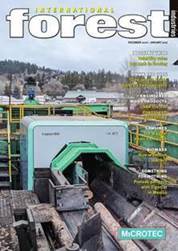EDITOR’S COMMENT ISSUE 57 JUN 2017 / JUL 2017
Risky business
The world today feels like a more risky – or at least more volatile – place than at any point in living memory for many in the forestry sector.
At the macro level, business is faced with a Donald Trump – led US, international terrorism, Brexit and the potential disintegration of the European Union, and, most recently, the very real threat of nuclear war breaking out from the Korean Peninsula.
These headlining concerns have created great uncertainty over the prospects for global economic progress, which of course drives demand for raw materials, including the most fundamental building material, wood.
Against this backdrop, business leaders are grappling with volatility across a number of fiscal metrics that all need to be considered in business planning.
For forestry professionals operating in international markets, this is largely about the fact much of the product being sold is done so in US dollars, but the cost of producing that material is paid in local currency.
Granted, this can work for or against a business depending on which way foreign exchange rates move, but the point is, it makes forecasting and preparing a business for all eventualities extremely difficult.
A Donald Trump tweet and a nuclear test out of North Korea around the same time as a large roundwood deal can potentially be the difference between a profitable and lossmaking month, if not quarter.
Most stakeholders International Forest Industries speaks to do not feel the risk environment will improve significantly even if the global economy shows signs of more stable growth. Put simply, businesses exposed to international economics and politics are likely to suffer from heightened volatility for as far out into the future as anyone dare predict.
This poses a challenge for decision makers at the head of forestry businesses.
The ability to identify, acknowledge and manage risks is today paramount for the successful running of any raw materials supplier or wood processing business of scale. It follows that technical competencies, though clearly fundamental in forestry, are being challenged in some respects by the need for better risk management skills, which have become an increasingly important attribute for executives and operational teams.
Risk management is arguably, with the exception of substitution and disruptive technologies, the most important issue facing forestry at the moment and everything points to risk continuing to be a major challenge for the industry in years to come.
This being the case, it is surprising that the major forestry shows currently taking place across the world fail to address the risk management aspect of our industry.
Sure, these shows are primary technical gatherings used to sell equipment on the spot and fill order books to secure a pipeline of work, but most of them also carry an educational programme with sideline presentations and lectures.
These presentations continue to focus on technical achievements and aspirations, which definitely shape individual businesses and will shape the future of forestry in general. But they could do more to highlight key issues that are already in play and effect the livelihoods of forestry practitioners today.
We would not suggest a separate event or even series of talks devoted to the topic of risk management but a keynote address on one day of just one event might at least open the door to a discussion that will be a much larger part of our working lives in an increasingly risky business world.
Enjoy
Chris Cann




